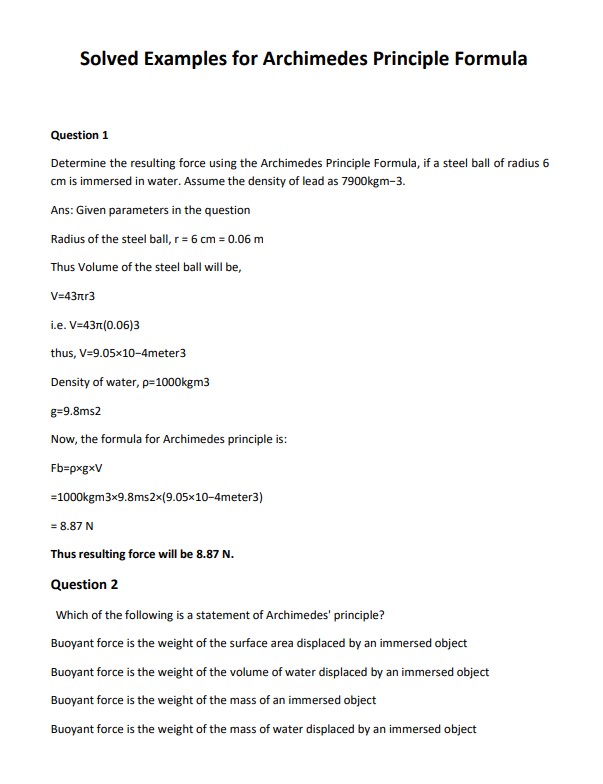Solved Examples for Archimedes Principle Formula
Summary:
The Solved Examples for Archimedes Principle Formula note contains solved examples related to the Archimedes Principle Formula. The examples involve calculating the resulting force, determining the submerged volume of an object, finding the net force acting on an object submerged in water, and calculating the density of a ball. The examples demonstrate the application of Archimedes’ principle, which states that the buoyant force experienced by an object immersed in a fluid equals the weight of the fluid displaced by the object. The examples involve calculations based on the given parameters, such as radius, density, volume, and gravitational acceleration. The solutions provide step-by-step explanations and highlight the concepts of buoyant force, volume displacement, and the relationship between density and mass.
Excerpt:
Solved Examples for Archimedes Principle Formula
Question 1
Determine the resulting force using the Archimedes Principle Formula, if a steel ball of radius 6
cm is immersed in water. Assume the density of lead as 7900kgm−3.
Answer: Given the parameters in the question
Radius of the steel ball, r = 6 cm = 0.06 m
Thus Volume of the steel ball will be,
V=43πr3
i.e. V=43π(0.06)3
thus, V=9.05×10−4meter3
The density of water, ρ=1000kgm3
g=9.8ms2
Now, the formula for Archimedes’ principle is:
Fb=ρ×g×V
=1000kgm3×9.8ms2×(9.05×10−4meter3)
= 8.87 N
Thus resulting force will be 8.87 N.
Question 2
Which of the following is a statement of Archimedes’ principle?
a. Buoyant force is the weight of the surface area displaced by an immersed object
b. Buoyant force is the weight of the volume of water displaced by an immersed object
c. Buoyant force is the weight of the mass of an immersed object
d. Buoyant force is the weight of the mass of water displaced by an immersed object
Answer:
– Buoyant force is the weight of the volume of water displaced by an immersed object
The Explanation for the Answer
Archimedes’ Principle states: When a body is totally or somewhat drenched in a liquid, the
liquid applies a vertical power on the body equivalent to the heaviness of liquid uprooted by
the body. Accordingly, the light power is reliant upon the thickness of the fluid and volume of
the inundated item, no matter what the article’s mass or surface region.


Reviews